Ajanta Caves - Overview
Ajanta Caves are situated in Aurangabad city in Maharashtra state of India. The caves were built in two phases. The first phase started from around 2ndBCE and the second phase started from around 480 or 650 AD. The caves mainly belonged to Buddhists as there are many pictures, idols, and pictorial tales that tell about Buddha and his rebirth.

Aurangabad
Aurangabad city is located in Maharashtra state and was named after the Mughal emperor Aurungzeb. There are many monuments in and around the city which the people can visit. Malik Amber was the founder of the city in 1610. Malik Amber was the Prime Minister of Shah Nizam who made Khadkias his capital.

After the death of Shah Nizam in 1626, Fateh Khan succeeded him and changed the name of the place to Fatehnagar. In 1633, Mughals captured Fatehnagar and Daulatabad and Aurungzeb was appointed as the viceroy of Deccan. Aurungzeb made Fatehnagar his capital and renamed it as Aurangabad.
Visiting Hours
Ajanta Caves are opened for the tourists from 9:00am to 5:30pm. Tourists can visit the caves on all days except Mondays. It takes around two to three hours to visit the caves as there are many things to see inside.
Tickets
Tourists have to pay an entry fee in order to visit the caves. Indian tourists have to pay Rs. 10 whereas the foreign tourists have to pay Rs. 250. If tourists want to carry still camera or video camera, they have to pay Rs. 25 extra. There is no charge for the children who are below 15 years.
Best Time to Visit
The period of June to March is the best time to visit the caves as the climate is very pleasant. In the remaining months of April and May, the temperature is very hot and the climate is unsuitable for visiting the caves.
Where to Stay?
The city nearest to Ajanta Caves is Aurangabad which is around 99km away. There are more than 200 hotels in Aurangabad that range from inexpensive hotels to expensive five-star hotels. Some of these hotels are as follows −
- Five-Star Hotels
- VITS Hotel located at Station Road
- Welcom Hotel Rama International located at Chikhalthana
- Ambassador Ajanta located at Cidco
- Vivanta by Taj Aurangabad located at Rauza Bagh
- Four-Star Hotels
- Lemon Tree Hotel located at Chikhalthana
- Keys Hotel The Aures located at Kranti Chowk
- Hotel Windsor Castle located at Cidco
- The Meadows located at Mitmita
- Hotel Gurjas located at Vinayak Patil’s Chowk
- Three-Star Hotels
- Hotel JP International located at Narailbag
- Hotel Green Olive located at Bhagya Nagar
- The Manor Hotel located at Osmanapura Kranti Chowk
- The Sky Court located opposite Railway Station
- Hotel Avon International located at Jalna Road
- Budget or Two-Star Hotels
- Hotel regal Plaza located at Bansilal Nagar
- Vijay Residency located at Cidco
- Hotel Admiral Suites located at Osmanapura
- Hotel Manmandir Executive located at Adalat Road
- Hotel Pearl located at Samarthnagar
- Cheap or One-Star Hotels
- Hotel Sparkling Pearl located at Cidco
- Hotel Venkateshwar located at Rokadia Hanuman Colony
- Hotel Deepali Executive located at Cidco
- Hotel Indradeep Executive located at Station Road
- Hotel Sahara located at Jalna Road
Ajanta Caves - History
Ajanta Caves were built in two phases and they have around 29 caves to be seen. The caves are numbered in order to identify them but that does not mean that they are constructed in the chronological order.
Caves constructed during Satvahan Period
The caves 9, 10, 12, 13, and 15A were constructed during this period and are considered as the earliest caves. These caves belong to the Hinayana sect of Buddhism. Out of these caves, cave 9 and cave 10 have Buddhist Stupas which have worship halls and caves 12, 13, and 15A have viharas.

Caves constructed during Vataka Period
According to the historians and various studies, it has been found that second phase of the construction of Ajanta caves started during the reign of Harisena, a king of Vataka dynasty. The caves constructed during this period belonged to the Mahayana sect of Buddhism.
The caves that were constructed during this period are 1 to 8, 11, and 14 to 29. Out of these caves, 19, 26, and 29 are chaitya grihas and rest are viharas. After the death of Harisena, construction of the caves came to a halt but were in use. Though some historians say that Buddhist used the caves but no stable community was present there.
Discovery of the Caves
John Smith discovered the caves in 1819 during his hunting campaign. While moving around, he came to cave 10 and then asked the villagers to remove the jungle that grew around the cave. Within a few decade, the caves became popular due to the paintings present inside. Nizam of Hyderabad converted the place into a museum.
Roads were also built during his reign and tourists were allowed to see the site by paying a small sum of money. This led to deterioration of the site but after independence, the caves came under government of Maharashtra which took measures to stop deterioration.
History of Paintings
There are several paintings that can be found in the Ajanta caves. People can mostly find Mural paintings that were made during both the phases. Ancient paintings show that they were made during the Satvahana period. Some of the caves have the paintings of Gupta period and later.

Ajanta frescos are classical paintings made on dry plaster surface. The paintings were elaborately made with distinguishing features. The ceilings of the caves were also elaborately decorated. Cave 1 has the paintings of Jataka tales which is related to previous lives of Buddha.
Ajanta Caves - Architecture
Ajanta Caves were built from the Basalt accumulated in the form of igneous rocks. These rocks were accumulated due to the volcanic eruptions occurred long back. The workers carved the rock with proper planning as cracks also occurred during the process.
The workers carved pillars, roofs, and idols out of the rocks. Along with this, painting work was also done. Tourists can enter the site through a gateway built between cave 15 and cave 16. The gateway is decorated with elephant and snake.
Monasteries
Most of the caves are in the form of Viharas having dormitories attached to them. At the back side of the caves, a sanctuary was built and each sanctuary has a statue of Lord Buddha in the center. Many other deities are also carved on the pillars and near the large statue of Buddha.

These caves were built during the second phase and were shifted from Hinayana sect to Mahayana sect. Due to all these features, they came to be known as monasteries. The center of the viharas are in the form of a square having rectangular aisles on each side. There are number of small cells which can be entered through the doors made up of wood.
Worship Halls
The worship halls, also known as Chaitya Grihas, was built in the form a rectangle. The halls are divided into a naïve and two aisles. The hall consists of a stupa and an aspe. A stupa is a hemispherical structure having the remains of Buddhist monks and nuns while apse is a semi-circular structure having a vault or semi-dome.

People performed circumambulation around the stupa which is surrounded by pillars. Some caves have large entrances having windows through which light entered the caves. The construction of the worship halls depicted the architecture of Christian church but they didn’t have any chapel.
Ajanta Caves - Description of Caves
There are around 29 caves on the site and the description of each one is as follows −
Cave 1 and Cave 2
Cave 1 is a monastery having a hall with 14 cells. The hall also have sanctuary and a verandah whose dimension is 10.5 x 2.82 x 4.1m. There is a courtyard with two cells, one on each side. There is a statue of Buddha that is seated in the mudra of dharma chakra parivartana
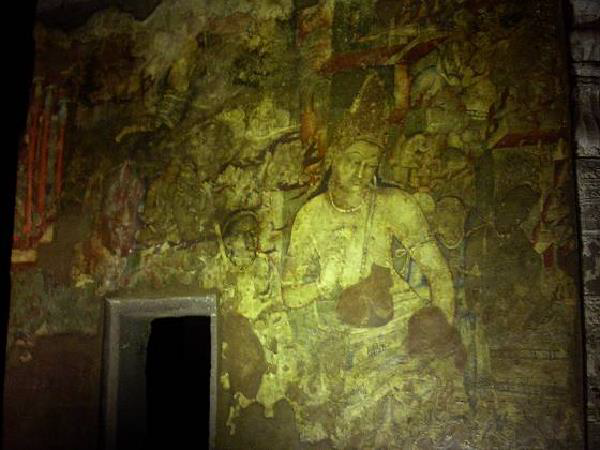
Cave 2 has the dimensions of 35.7 x 21.6. The cave includes cells, sanctuary, and subshrines. There is a statue of Buddha who is seated in the mudra of dharma chakra parivartan. Each sub-shrine has a painting of Yaksha known as Sankhanidhi and Padmanidhi. Along with it, the figures of Panchika and Hariti can also be found. The ceiling is painted with Jataka tales.
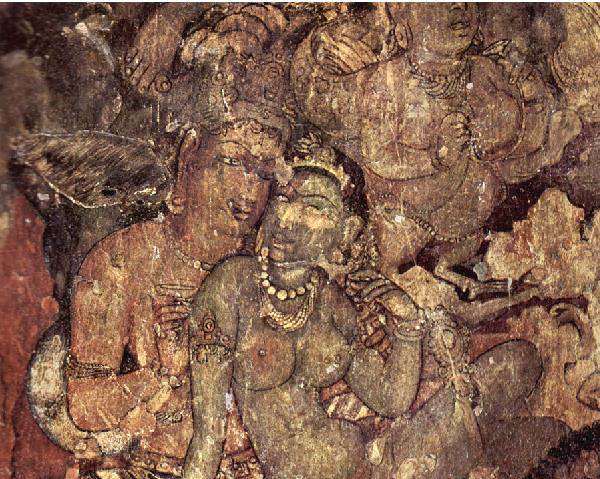
Cave 3 to Cave 5
Cave 3 has the dimensions of 10.08 x 8.78. The cave is an incomplete monastery and only a pillared verandah can be found here. Cave 4 is a monastery in square shape and has a hall, a sanctuary, and a pillared verandah. The dimensions of the monastery is 35.08 x 27.65m.
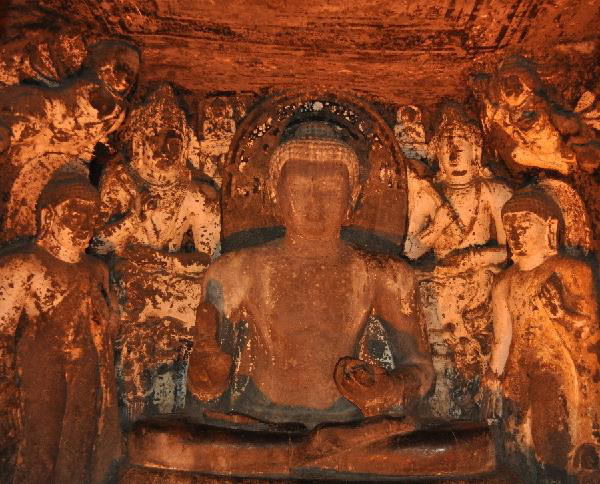
The frame of the door is carved with Bodhisatva and eight great perils. Cave five is an incomplete monastery whose dimensions is 10.32 x 16.8m. The frame of the door is carved in a sophisticated manner. Female figures can also be found in the cave.
Cave 6
Cave 6 is a monastery having double storey and has the dimension of 16.85 x 18.07m. A sanctuary and a hall can be found on the first floor. The second floor has a hall with cells, sub-cells and sanctuary.
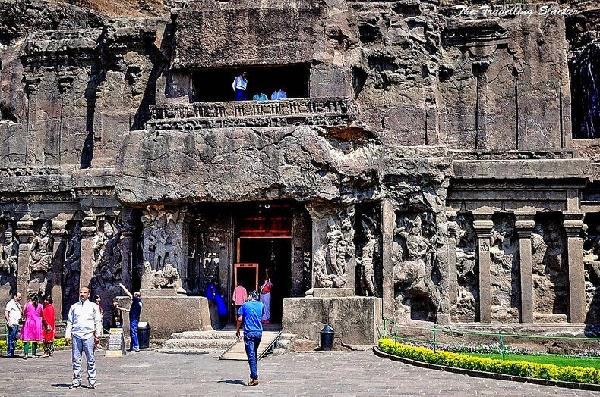
Along with these, there is a statue of Buddha installed in both sanctuaries. The statue shows that Buddha is teaching his disciples and followers. Paintings of Sravasti and Mara’s Temptation can also be found here.
Cave 7 and Cave 8
Cave 7 has the dimensions of 15.55 x 31.25m. The cave has a sanctuary along with a hall with two small verandahs. The ceiling of the hall is supported by pillars having octagonal shape and has eight cells. The sanctuary has a statue of Buddha preaching to his disciples. Paintings of Buddha under the presence and protection of Nagamuchanda is also there.
Cave 8 has the dimensions of 15.24 x 24.64m. It is an incomplete monastery and is considered as one of the earliest caves. Some portions of the cave were ruined due to a landslide.
Cave 9 and Cave 10
Cave 9 is a chaitya griha having the dimensions of 18.24 x 8.04m and belongs to Hinayana sect of Buddhism. The cave has a door with two side windows, and a central hall. The aisles in the hall are separated by 23 pillars. The hall also has a stupa for worshipping.
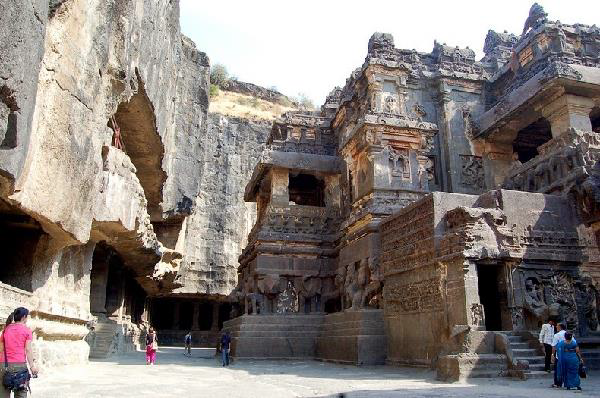
Cave 10 has the dimensions of 30.5 x 12.2m having two aisles on each side which are divided by 39 octagonal pillars. There is also a stupa where the followers used to worship. The paintings in the caves depict the stories of Sama Jataka and Chhaddanta Jataka. One of the paintings belong to 2ndcentury BC while the other belongs to 4th to 8th century.
Cave 11 and Cave 12
Cave 11 is a monastery having the dimensions of 19.87 x 1735m. The cave has a hall with long bench and six cells. The verandah in the cave is pillared and has four cells. The statue of Buddha can be found in the sanctuary. An incomplete stupa can also be found in the cave.
Cave 12 is a Hinayana monastery having the dimensions of 14.9 x 17.82m. The hall has twelve cells arranged on its side. The first wall of the hall has collapsed. An inscription on the wall tells that a merchant namedGhanamadada gifted this cave during the period of 2nd century BC to 1stcentury BC.
Cave 13 to Cave 15
Cave 13 is a Hinayana monastery having a collapsed façade and a square hall. Rock-cut beds can be found in the three cells. These cells are located on each side of the hall. Cave 13 is one of the earliest caves that was found during excavation.
Cave 14 can be found above cave 13 and is a monastery whose dimensions is 13.43 x 19.28m. It is an early Mahayana Vihara which has sala bhanjikas on the corners of the doorway.
Cave 15 is a monastery that belongs to Hinayana sect of Buddhism and was built in 5th century AD. The dimensions of the cave is 19.62 x 15.98m. The cave has a verandah, a hall and a shrine having many images of Buddha.
Cave 15A and Cave 16
Cave 15A is the smallest cave in Ajanta. It has a central hall with three cells, one on each side. There was an inscription on the front wall. The chaitya window in the hall is built according to vedica pattern.
Cave 16 is a monastery of Mahayana sect of Buddhism. There is a painting in which it is shown that Princess Sundari is very happy when she came to know that her husband, Nanda, is going to become a monk. Nanda was the half-brother of Buddha.
Cave 17
Cave 17 is a monastery that belongs to Mahayana sect. The caves has many paintings on the doors, walls, and ceiling. The ceiling has the paintings of musicians and maidens while paintings of Buddha, lotus petals, goddesses and other paintings were made on the door.
One painting shows King Simhala fighting with ogresses who ate humans. Another painting shows the flying gods with their apsaras. There are seven statues of Buddha seating with the future Buddha. Each statue is seated under a Bodhi tree.
Cave 18 and Cave 19
Cave 18 is rectangular in shape having the dimensions of 3.88 x 11.66m. The hall has two pillars having moulded bases and octagonal shaft. Cave 19 is a chaitya griha whose dimensions is 16.05 x 7.09m.
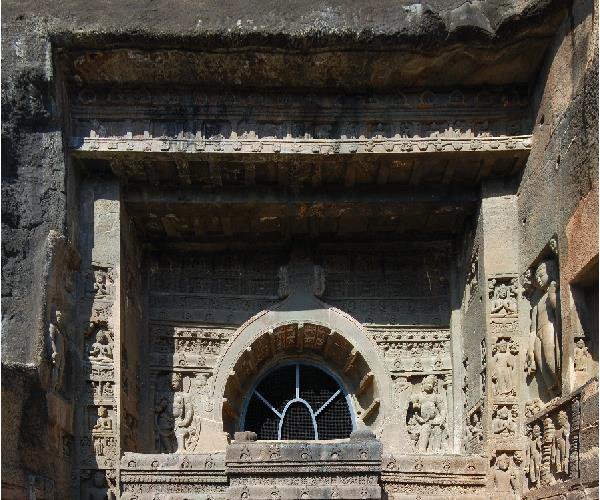
The stupa in the cave has a large statue of Buddha. There are two images of Yakshas that and each lies on either side of the arch. The walls in the hall are painted with the images of Buddha sitting in different postures.
Cave 20
Cave 20 is a monastery that belongs to Hinayana sect of Buddhism. The verandah of the cave has carved columns and bracket figures. There is a hall in the cave having no columns. People can go to the shrine through an antechamber attached to the hall. The antechamber has two chambers one on each side.
Cave 21
Cave 21 is a monastery whose dimensions is 28.56 x 28.3m. There is a hall with twelve cells out of which four cells have pillared porches. Another feature in the hall is the twelve pillars. Along with this, the cave has sanctuary and a pillared verandah. The sanctuary has a statue of Buddha which depicts that he is preaching to his disciples.
Cave 22
Cave 22 is located on the left side of cave 21. The cave is a vihara having a collapsed verandah and a hall. The hall has two incomplete cells on left and right side. A Buddha figure can be found inside the shrine.
Cave 23
Cave 23 is a monastery having the dimensions of 28.32 x 22.52m. The monastery has a hall with cells on its sides. Other structures found in the cave are a sanctuary, antechambers and a verandah.
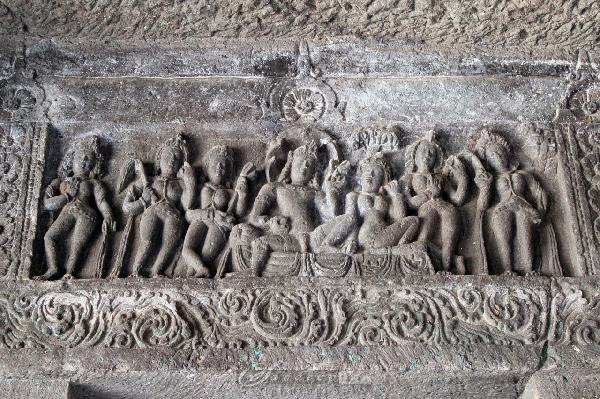
The construction of the cave could not be finished but still the pillars inside are welldecorated. The cave also has images of naga depicted as doorkeepers. Along with this, pilasters or rectangular columns can also be found in the cave.
Cave 24 and Cave 25
Cave 24 is a monastery having the dimensions of 29.3 x 29.3m. The cave has a hall with a pillared verandah and a sanctuary. There is a chapel outside the verandah which is also pillared. There is a statue of Buddha having the posture of pralamba-padasana.
Cave 25 is a monastery having the dimensions of 11.37 x 12.24m. The cave has a courtyard, a hall, and a pillared verandah. There are two cells on the left of the verandah but no cells are there in the hall. Another feature of the cave is that there is no shrine in the cave.
Cave 26
Cave 26 is a prayer hall of Mahayana sect. in which a large statue of Buddha is installed. The statue shows the death of Buddha and below it are the statues of followers who are mourning for him. Above the statue of Buddha are statues of heavenly beings who are rejoicing as Buddha is coming back. There is also a stupa in the cave having a statue of Buddha.
Cave 27 to Cave 29
Cave 27 has two storeys out of which one is partially collapsed. The cave is a monastery having a hall with four cells. Other structures in the cave are a sanctuary and an antechamber. There is a statue of Buddha in the sanctuary. The statue depicts that Buddha is teaching his disciples.
Cave 28 is a monastery and has only a pillared verandah. Nothing much is excavated in this cave and also it is not fully constructed. Cave 29 is a chaitya griha having the dimensions of 22.8 x 12.84m. The cave is located between cave 20 and cave 21.
Ajanta Caves - How to Reach?
Ajanta caves can be easily reached from Aurangabad and Jalgaoncities. Aurangabad is 99km away from Ajanta caves while Jalgaon is only 59km away. Aurangabad is wellconnected to Indian cities by air, rail, and road transport.

The approximate distance of Aurangabad from various cities is as follows −
- Aurangabad to Mumbai
- By air – 265km
- By rail – 253km
- By road – 327km
- Aurangabad to Jalgaon
- By rail – 273km
- By road – 161km
- Aurangabad to Hyderabad
- By air – 433km
- By rail – 508km
- By road – 540km
- Aurangabad to Bhusaval
- By rail – 272km
- By road – 164km
- Aurangabad to Nagpur
- By air – 426km
- By rail – 621km
- By road – 487km
- Aurangabad to Pune
- By air – 212km
- By rail – 426km
- By road – 230km
- Aurangabad to Manmad
- By rail – 52km
- By road – 114km
By Air
Aurangabad has an airport which is 10km from the city and its name is Chikkalthana airport. The airport is well connected to Mumbai, Jaipur, Udaipur and Delhi. People can reach Aurangabad through flights and hire a cab or take a bus to Ajanta caves.

By Train
Aurangabad is well-connected to major cities of India through railway network. Many trains of long and short routes have stoppage here and people from various cities can come to Aurangabad by train and then take a bus or taxi to visit Ajanta caves.

By Road
Aurangabad bus station provides buses to many major cities. The bus stand is located on Jalgaon road in front of Lemon Tree hotel. The buses connects Aurangabad to Mumbai, Pune, Nagpur, and other major cities.

Local Transport
Tourists can move around Aurangabad through auto rickshaws and local buses. Besides these, there are various agencies in the city from where tourists can book taxis for a fixed period of time and move in and around the city.
Ajanta Caves - Nearby Places
Ajanta caves is very popular among the tourists and many of them come from various places in India and abroad to visit the caves and know about their history. Besides these, there are many other places which the tourists can visit nearby Ajanta caves. Some of these places are as follows −
Kailasanatha Temple
Kailasanatha Temple is a Hindu temple located in cave 16 of Ellora caves. The temple was built from a single rock and depicts the Kailash parvat or Kailash hill where Lord Shiva resides.

The temple has a pyramidal structure and has images of many deities. The temple also has an image in which Lord Vishnu has taken an incarnation in the form of a man-lion and fighting with a demon.
Bibi ka Maqbara
Bibi ka Maqbara is also known as Taj of Deccan. It was built by Aurangzeb in the memory of his wife Rabia ul Daurani also known as Dilras Banu Begum. The mausoleum was built with white marble on a square platform.

There are four minarets, one each at its four corners. A museum is also there on the rear side of the monument which has items used in Mughal period.
Aurangabad Caves
Aurangabad Caves are situated between Satara and Sihyachal mountain ranges. These caves have the temples which were built in between 6th and 8thcenturies. The temples in the caves were built on the basis of Buddhist architecture. There is a popular shrine that is based on Sutosama Jataka.

Daulatabad Fort
Daulatabad Fort is situated on a 600 feet high hill. The construction of the fort is based on the forts constructed on ground and hills. Three walls, known as kots, surround the fort so the fort is considered as one of the most power forts.

Bhadra Maruti Temple
Bhadra Maruti Temple is located in a town called Khuldabad. It is a Hindu temple where people assemble especially during the festival of Hanuman Jayanti and Ram Navami. The idol of Hanuman is installed here in sleeping posture. On Saturdays, people come from Aurangabad come here on foot to perform puja.


Comments
Post a Comment